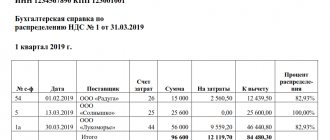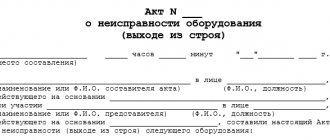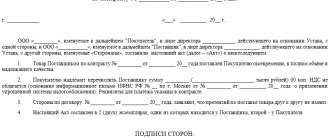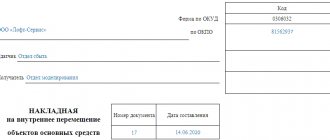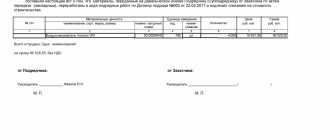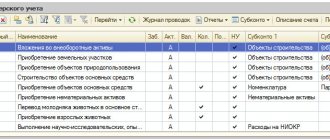Drawing up an act in form OS-15 occurs in cases where any equipment received at the enterprise’s warehouse, regardless of its type, name, purpose and other parameters, is transferred for installation. Most often, the act is in demand in various types of construction organizations dealing with complex technological equipment and machinery.
- Form and sample
- Free download
- Online viewing
- Expert tested
FILES
Application of the OS-15 act
Depending on what forms the company decides to use (unified or independently developed), it is worth either determining the procedure for filling out independently developed forms, or using the filling instructions approved by Goskomstat. If a company decides to use a unified form, it is necessary to understand some of the features of filling out the act in form OS-15. We will provide a form and a sample of filling out the act at the end of the article.
If the installation of purchased equipment is carried out on its own, then the act is filled out at the time of the actual transfer of the equipment for installation. The act must be completed in two copies. If the installation is carried out by a third-party company under a contract method, the acceptance committee includes a representative of the contract installation organization. There is no need to draw up a separate OS-15 act for transferring equipment for safekeeping: when receiving equipment for storage, an authorized representative of the installation organization signs directly on the act, and a copy of the act is given to him.
Design features
When completing the procedure for acceptance and transfer of equipment items for installation, it is necessary to comply with certain points:
- mandatory participation of each party having the right to sign;
- when executing a transaction on the territory of the transferring party, the receiving organization provides a power of attorney to the authorized person;
- when the process takes place on the territory of the receiving party, an act of acceptance of components for installation is drawn up by it (simultaneously with the equipment); recipients are given accompanying documentation;
- Recipients of equipment can involve third-party experts to study it in more detail.
When accepting equipment, you should very carefully check that the serial numbers on the fixed assets themselves and on the invoices match.
Act OS-15 (filling sample)
The form for the certificate of transfer of equipment for installation is filled out on both sides of the sheet. In the header of the document, general information is filled in, namely: name of the customer organization, structural unit, OKUD and OKPO form, basis for drawing up the document (name), its number and date of completion. Next, fill in the invoice, sub-account, analytical accounting code, date of delivery of the purchased equipment for installation, date of commissioning of the equipment - the actual date and the date determined by the contract. The document number and date of completion are indicated.
The main part contains general information about the acceptance and transfer of equipment for installation:
- Place of filling out the act, code according to OKPO;
- Name of the manufacturer, OKPO code;
- Name of the supplier company, OKPO code;
- Name of the company performing the installation, OKPO code.
The following contains detailed information about where the equipment was transferred for installation - the exact name of the building and the company's workshop. Information about the transferred equipment is presented in detail in a table consisting of eleven columns:
- Name of the equipment that was transferred for installation;
- Serial number assigned to the purchased equipment;
- Passport or marking number;
- Position number according to the technological diagram;
- Type, brand of equipment purchased;
- The date when the equipment arrived at the customer’s warehouse;
- Acceptance certificate number;
- Number of units of received equipment;
- Cost of one piece of equipment;
- The final (total) cost of the equipment that was purchased;
- Notes.
The reverse side of the OS-15 form contains detailed information about what was discovered during the installation of the equipment. In particular, it is necessary to record whether the equipment corresponds to the design specification or drawing. If the equipment does not comply with the declared parameters, then indicate the discrepancy. Note whether the equipment was received with technical documentation, describe in detail the composition of the kit in which the equipment was received.
Form OS-15 also includes information about equipment defects: if any were discovered, they must be listed. The detailed content and description of defects should be recorded in a separate act on identified defects (form OS-16).
In conclusion, the certificate of transfer of equipment for installation OS-15 contains information about the suitability of the equipment for installation. The act is signed by a representative of the customer company, which handed over the equipment for installation, and a representative of the company carrying out the installation, indicating the position held and a transcript of the signature. Also, the OS-15 act (a sample of the filling below) is signed by the financially responsible person, indicating the position and a transcript of the signature - this confirms the fact that the equipment has been accepted for safekeeping. One copy of the act must be given to the financially responsible person. The date the document was completed is indicated.
Below you can download the unified form of the OS-15 act and see an example of how to fill it out.
Form OS-15 (filling sample)
How to fill out the first page of the form
Filling out the 1st page of the act in form OS-15 is carried out in the following order:
- Customer – the name of the company that transfers its special equipment for installation, as well as its OKPO code.
- Basis - the name of the document on the basis of which this act is filled out (mainly a work contract).
- Account – account number. the account on which the objects will be listed before they are accepted for accounting.
- The date when the special equipment was handed over for installation.
- The place of formation of the act is the address and name of the company where this act was filled out.
- Manufacturer – the name of the company that manufactured the objects.
- Supplier – the name of the company that sold the special equipment.
- Installation organization - the name of the company that will install the objects.
After the equipment has been installed and is ready to be put into use, the line for the actual date of transfer is filled in. That is, the line is filled in upon completion of the work.
After this, they begin to fill out the table.
If an error is found
It is understood that the document must be compiled without spelling, grammatical, punctuation and factual errors. If the latter was detected, you must resort to the standard algorithm:
- a number or word with an error is crossed out carefully;
- the correct option is indicated next to or above;
- further about;
- sign and date the correction to confirm the actions taken.
Both parties to the contract must be notified of any amendments.
If there are many mistakes made, then it will be better to draw up a new act or print and fill out a blank form, and destroy the old copy with the error.
What information must be included in the preamble?
The act is an official document, but it is drawn up in free form with the inclusion of mandatory details. In the event of any problematic situations, only a document containing all the information prescribed by law will be recognized in court . The preamble is drawn up in accordance with generally accepted standards for drafting contracts and agreements. The form of the act begins with the title “Act of acceptance and transfer of materials to agreement No.____ dated _____ between ______ and ______.” Without specifying the details of the main agreement and the date of preparation, it will be considered invalid.
Next, the official name of the customer’s company, its legal address and all details of the responsible person (position, full name, passport details) are indicated as standard. Similar information is indicated about the contractor, after which the document most often uses the wording “The Customer transfers and the Contractor accepts the following materials” and proceeds to the transfer.
Accounting for equipment requiring installation
The Chart of Accounts and Instructions for its use to summarize information on the availability and movement of technological, energy and production equipment that require installation and are intended for installation in facilities under construction or reconstruction provide for active account 07 “Equipment for installation” (Order of the Ministry of Finance dated October 31 .2000 No. 94n).
This account also takes into account equipment that is put into operation only after its parts have been assembled and attached to the foundation or supports, to the floor, floors and other load-bearing structures of buildings and structures, as well as sets of spare parts for such equipment. As equipment requiring installation, control and measuring equipment or other devices that are intended for installation as part of the installed equipment are taken into account.
What form should I use to receive an object?
The law does not establish a single method for registering an act.
Companies can, at their discretion, choose either the unified OS-15 form or their own developed form .
The approved form is more convenient to use because all the necessary points are already included in the structure of the document; there is no need to add anything.
This will prevent possible errors in completing the procedure for accepting and transferring an asset for installation.
Key points on drawing up and executing the act
Today, organizations and enterprises, when transferring equipment for installation to complete this procedure, can choose one of two methods:
- or draw up an act in any form,
- or use a standardized sample recommended for use.
The good thing about the second option is that when filling out the template, you don’t need to rack your brains over the structure and content of the document; all the necessary points have already been included in it.
Among other things, here are indicated
- all organizations related to the received equipment: manufacturer, supplier, transporter, buyer, customer, installation company, etc.,
- their details
- information about the equipment itself,
- information about responsible persons,
- As a basis, a reference to the contract agreement is included in the act.
The form can be filled out either by hand (only with a ballpoint pen, never with a pencil) or on the computer.
It must be drawn up in two copies,
- one of which should subsequently be transferred to the accounting department, where it will act as a confirming document for the transfer of equipment from the customer to the installation organization and will serve as the basis for registering the equipment as a fixed asset,
- send the second to the installation contractor.
If necessary, you can make additional copies of the act.
Briefly about the agreement
Work under a contract is regulated by Art. 702-729 Civil Code of the Russian Federation. The contract specifies all information regarding the work:
- what work will be performed;
- what materials will be provided by the customer;
- timing and method of transfer of materials;
- turnaround time;
- the obligation of the performer to return unused materials and more.
In addition to the contract, the following documents are also drawn up:
- act of acceptance and transfer of materials or equipment;
- invoice for the release of materials to the third party (according to form M-15 or a self-developed one);
- receipt order according to the recommended form M-4 - it is drawn up by the contractor after he receives the materials (if the raw materials need to be distributed among warehouse premises and several performers);
- certificate of completed work - also filled out by the contractor after completing the work.
For your information! This list can be shortened or expanded by agreement of the parties.
Equipment for the production of toilet paper. How toilet paper is made
The minimum set for the production of toilet paper is as follows:
Cutting machine cutting rolls from rollers
- Band saw for cutting logs of toilet paper into rolls, JQ-D (Manufacturer-HAC);
- VC-90 Automatic planetary saw for cutting toilet paper rolls (Manufacturer: HAC);
- Equipment for cutting toilet paper from waste paper RTB 1000;
- Cutting machine (band saw) PL-41/PL-45 (Manufacturer NIKA, Russia)
Rewinding and winding machine designed for rewinding raw materials
- Unwinding machine for the production of toilet paper BRS-18/2000 (Manufacturer OBS LLC);
- Unwinding machine for processing toilet paper (Manufacturer Dazen);
- Paper unwinding machine (Manufacturer: Omsk Paper Plant);
- Rewinding machine RNS 2100;
- Machine for rewinding toilet paper into rolls MNB-2E;
- Equipment for rewinding toilet paper from waste paper PTB 1000;
- Rewinding and winding machines PM-1, PM-2, PM-3, PM-4, PM-4A, PM-5/PM-5A, PM-6 (Manufacturer NIKA, Russia);
Bushing machine - for the production of cardboard bushings
- VC-180J Equipment for the production of cardboard sleeves (Manufacturer -HAC);
- Universal bushing machine – VT 42 and VT 45 (Manufacturer NIKA, Russia);
Pasting machine (in case of sticking the manufacturer’s logo on the finished product)
- Wrapping machine OS-15 (Manufacturer NIKA, Russia);
Packing machine
- Packaging machine US-5T (Manufacturer NIKA, Russia).
Examples of workshop equipment:
- VC-2200 equipment for the production of toilet paper from finished raw materials (Manufacturer -HAC);
- VC-1350 equipment for the production of toilet paper (Manufacturer -HAC);
- Equipment for the production of toilet paper SPM 2100 (Manufacturer: Thai Shuen enterprise CO).
The productivity of a toilet paper production workshop depends on the calculated productivity of the machines, the speed of winding and filling of paper, as well as the human factor. The estimated cost of such a workshop is about 4-5 thousand USD
Automated lines
The lines are designed for perforating, embossing and cutting raw materials in accordance with specified sizes. Such lines, depending on the modification, can process rolls with a width of 1200, 1750, 1950, 2150, 2350, 2550 and 2750 mm. For example,
- Toilet paper production line, PM-1150/1.8 (Manufacturer OBS LLC);
- Toilet paper production line (Manufacturer solaris);
- Automatic line for the production of toilet paper, 24 ();
The line includes: Rewinding and winding machine ARNS-24; Bushing machine VT-42; Cutting machine PL-41; Universal Packaging Machine US-5T; Pasting machine OS-15.
- Automatic cutting line for toilet paper and paper towels DM (Manufacturer Turkey);
The cost of such a line is determined by its capacity and amounts to 30-50 thousand USD.
In addition to conventional lines, there are lines designed for the production of paper from straw.
Tension control systems
Tension control systems play an important role in the production process, since maintaining a constant tension is necessary for high-quality roll formation. There are two types of such control systems: open and closed. The choice should be made based on production needs and technical characteristics of the equipment. The leading companies in tension control systems are Whichita (UK) and WarnerElectric (USA, France).
Auxiliary elements
An important role in the production process of toilet paper is given to the quality of the following elements:
- band knives of various types;
- circular knives (for rotary cutting machines);
- pulse packer;
- rotomat;
- automatic toilet paper log storage device;
- automatic machine for the production of sleeves (cardboard sleeves), etc.
Raw materials
The raw material for the production of toilet paper is tissue paper (SGB), which is produced in 1-2 meter rolls weighing from 100 to 600 kg. Its quality is guaranteed by the relevant GOST standards. From a business point of view, it is more effective not to purchase ready-made SGB, but to produce it independently.
Waste paper, straw and cellulose can also be used as raw materials. For their processing, so-called mills are used. For example, a mill for processing cellulose with double millstones (Manufacturer Dazheng) worth 6,000 USD.
The following grades of waste paper are used for the production of toilet paper: MS-1; MS-2; MS-3; MS-7 and MS-10. If you plan to process waste paper, then the paper manufacturer should acquire special equipment, namely a paper-making machine. For example,
- Paper Making Machine (Manufacturer: DaZeng);
- Paper making equipment ke-hua;
- Paper-making machine, PM-1092 (Manufacturer Omsk Paper Plant);
- Mini plant for the production of toilet paper from waste paper 757.1092 (Manufacturer China);
- Mini-plant for processing waste paper into toilet paper PM (Manufacturer: Omsk Paper Plant).
Procedure for transfer to installation
The scheme by which organizations accept equipment, devices and equipment received from the supplier is approximately the same.
- First, the object arrives at the warehouse, where it is checked,
- Then it is transferred to installation,
- After assembly and adjustment work, if no flaws or malfunctions are identified during the process, it is received and registered as a fixed asset.
Act OS-15 is drawn up at the second stage of this multi-stage procedure, namely after acceptance, immediately at the time of transfer for installation and testing.
How to correctly draw up a list of transferred property
The compilation of a list of materials to be transferred to the customer and contractor must be approached most seriously. It is usually presented in the form of a table with the following columns:
- serial number;
- name of product/material;
- quantity (in pieces, kilograms or other units of measurement);
- weight (if necessary);
- total cost;
- unit price.
Next, indicate the total quantity and value of all property - in numbers and in words. If the customer simultaneously transfers any documents (warranty cards, instructions, etc.) with the materials, this must also be included in the list.
The court recognizes only a document containing all the information prescribed by law
At the stage of compiling the list or at least signing the act, it is necessary to conduct a joint inspection and recalculation of all materials . If any defects are discovered, detailed information about them must be included in the report (or the contractor must refuse to accept damaged materials).
In the event that defects are discovered after the document is signed by both parties, the contractor is unlikely to be able to make claims to the customer - they will be considered to have appeared after the conclusion of the agreement due to the fault of the contractor. A joint inspection and assessment of the entire list will help in the future to avoid claims against each other or litigation.
A few words about accounting for a contract
The transferred materials do not become the property of the contractor, that is, they are listed on the customer’s balance sheet. The posting for the transfer will be as follows: DT 10-7 “Materials transferred for processing to third parties” KT 10-8 “Construction materials” - materials were transferred to the contractor for processing on a toll basis.
Materials are not written off, but are accounted for in a separate subaccount. After the work is completed and accepted, the accountant makes the following entry: DT 08 CT 10-7 - the cost of the materials consumed is included in the initial cost of the object.
How to fill out the tabular part of a document
The columns of the tabular part of the act are filled in as follows:
- 1 – name of special equipment;
- 2 – serial number of the object;
- 3 – equipment passport number;
- 4 – equipment position number according to the technological diagram;
- 5 – type and brand of object;
- 6-7 – date and number of the act on the basis of which the equipment was received at the warehouse;
- 8 – number of objects in pieces;
- 9 – price of one object;
- 10 – total cost of all equipment;
- 11 – column for notes.

